House of Sickingen
Sickingen is the name of an old southwest German aristocratic family. The lords of Sickingen belonged to the Kraichgau uradel or ancient nobility and, from 1797, to the imperially immediate Hochadel or high nobility.
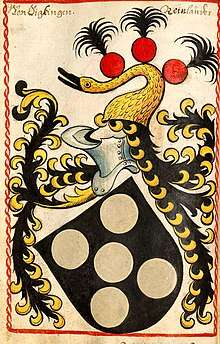
The Sickingen-Sickingen line died out in 1834, the Sickingen-Hohenburgs in 1932.[1]
Municipal coats of arms
Colours and elements, especially the five balls, from the Sickingen coat of arms still appear today in many county, town and village coats of arms in the former territory of the Sickingens.
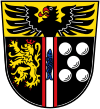 County of Kaiserslautern
County of Kaiserslautern Town of Landstuhl, county of Kaiserslautern
Town of Landstuhl, county of Kaiserslautern Landstuhl, county of Kaiserslautern
Landstuhl, county of Kaiserslautern Otterberg, county of Kaiserslautern
Otterberg, county of Kaiserslautern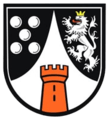 Town of Bad Münster am Stein-Ebernburg, Landkreis Bad Kreuznach
Town of Bad Münster am Stein-Ebernburg, Landkreis Bad Kreuznach Wallhalben, county of Südwestpfalz
Wallhalben, county of Südwestpfalz Waldfischbach-Burgalben, county of Südwestpfalz
Waldfischbach-Burgalben, county of Südwestpfalz Municipality of Sauerthal, county of Rhein-Lahn-Kreis
Municipality of Sauerthal, county of Rhein-Lahn-Kreis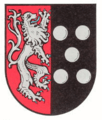 Municipality of Bann, county of Kaiserslautern
Municipality of Bann, county of Kaiserslautern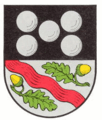 Municipality of Hauptstuhl, county of Kaiserslautern
Municipality of Hauptstuhl, county of Kaiserslautern Municipality of Kindsbach, county of Kaiserslautern
Municipality of Kindsbach, county of Kaiserslautern
Barony of Sickingen
The Barony of Sickingen was divided into the "Great Jurisdiction" (Großgericht) and the "Little Jurisdiction" (Kleingericht).[2]
Within the Großgericht were the villages of Bann, Harsberg, Hermersberg, Horbach, Kindsbach, Krickenbach, Linden, Queidersbach, Weselberg and Zeselberg.
The Kleingericht oversaw the villages of Gerhardsbrunn, Hauptstuhl, Kirchenarnbach, Knopp, Langwieden, Martinshöhe, Mittelbrunn, Mühlbach, Oberarnbach, Obernheim, Scharrhof and Schauerberg,
Bearers of the name
- Schwickart the Younger of Sickingen (died 1478), Amtmann
- Schweickhardt of Sickingen (died 1505), imperial knight, father of Franz von Sickingen
- Reinhard of Sickingen (born around 1417; died 1482), Prince-Bishop of Worms, held office from 1445 to 1482
- Francis of Sickingen (born 1481; died 1523), imperial knight and leader of the Rhenish and Swabian knights
- Johann Damian von Sickingen (18th century), Inhaber of an imperial infantry regiment
- Ferdinand Damian von Sickingen, Commander of the German Order of St. Aegidius, (1734-1736)
- Karl Heinrich Joseph von Sickingen (born 1737; died 1791), diplomat and chemist
- Karl Schweikard von Sickingen (died 1711), Knight of the Teutonic Order
- Kasimir Anton von Sickingen (born 1684; died 1750), Prince-Bishop of Constance, held office from 1743 to 1750
- Karl Ludwig von Sickingen-Ebernburg, Abbot of Kornelimünster Abbey 1745–1764
- Franz von Sickingen (died 1834 in Sauerthal), imperial count and castle lord of the Sauerburg. Last member of the noble family[3]
References
- Detlev Schwennicke (ed.): European family trees NF 11 (1986), Tree 68
- Michael Frey: Versuch einer geographisch- historisch-statistischen Beschreibung of the königl. bayer. Rheinkreises, Vol. 4, F.C. Neidhard, 1837, p. 178 (Googe Books)
- Sauerthal Regionalgeschichte.net
Literature
- Hans-Joachim Bechtoldt: Wappensiegel der Sickinger. In: Jahrbuch für westdeutsche Landesgeschichte, 34th Yearbook, 2008, pp. 129–167 [not evaluated]
- Michael Benz: Sickingen – Bildnisse. G. Peschke GmbH Druckerei, Munich, 1985 [not evaluated]
- Joachim P. Heinz: Der Reichsdeputationshauptschluss (1803) und die Auflösung der pfälzischen Grafschaften Wartenberg, Sickingen und von der Leyen. In: Mitteilungen of the Historischen Vereins der Pfalz, 111. Vol., 2013, pp. 185–265 [not evaluated]
- Otto Hupp: Münchener Kalender 1903. Buch u. Kunstdruckerei AG, Munich / Regensburg, 1903.
- Ernst Heinrich Kneschke: Neues allgemeines deutsches Adels-Lexicon. Vol. 8, Friedrich Voigt's Buchhandlung, Leipzig, 1868, pages 485–486. (digitalised)
- Genealogisches Handbuch des Adels, Adelslexikon Vol. XIII, Vol. 128 of the complete series, C. A. Starke Verlag, Limburg (Lahn), 2002, ISSN 0435-2408
External links
| Wikimedia Commons has media related to House of Sickingen. |